My expat sources here in Berlin tell me that everyone has a washing machine in their apartment, which explains why there are so few laundromats for such a large population. But our apartment happens to be one of the ones without a washing machine, so for our weekly wash we’ve got to load everything up in our suitcases and head over to Waschhaus 38, about 10 minutes walk from our place.
This week was my first week in the laundry rotation, and so first thing this morning Oliver and I packed up the clothes, sheets and towels and headed out.
Waschhaus 38 is extremely bright and clean; I remember laundromats as dingy places full of the smell of smoke (from the ever-present smokers) and dryer sheets. This one, though, is completely neutral in smell, without a hint of dinginess; there are even brightly-coloured couches and chairs upstairs to relax on. When we arrived at 9:00 a.m. the place was deserted:
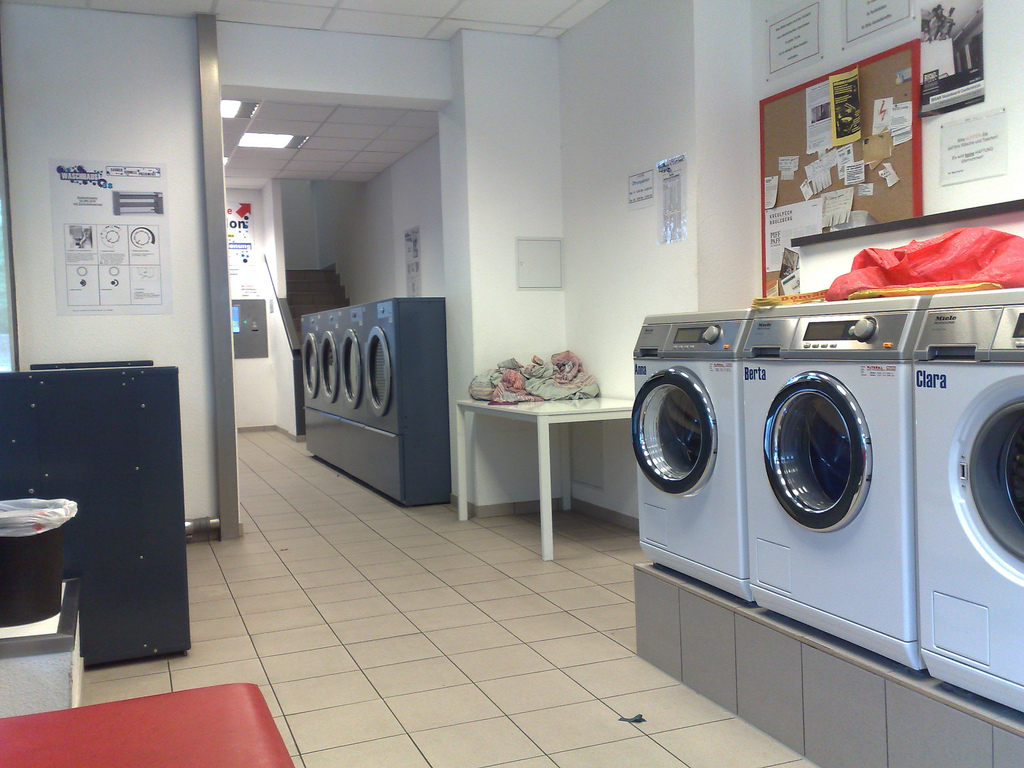
I haven’t done laundry in a laundromat for a long time – not since the days of the Laundromat Café on University Avenue in Charlottetown – but it strikes me that it’s awfully expensive to do laundry here at €4 for a wash. That said, if you use the super-high-speed 1400 rpm washing cycle clothes emerge almost completely purged of water, which cuts down on dry time.
At Waschhaus 38 all the washers and dryers have names. Among those we used today were my favourites, Frieda and Gerda (Gerda’s “G” has been chipped away at so she looks like she’s Cerda now, but she’s not):
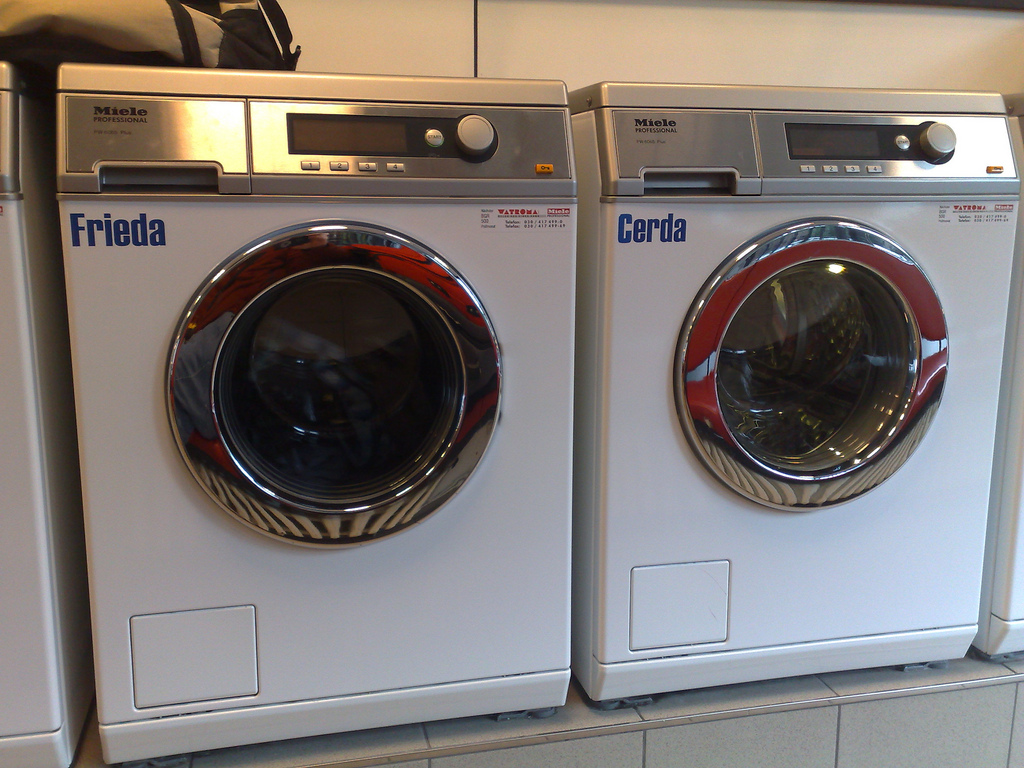
To pay, rather than putting money in the washers themselves you go to the far end of the room and use a touch screen to select your washer or dryer; you’re then prompted to enter the right amount of money and then told to go back and press “start” on the unit itself. It’s all very sensible and efficient, and the machine takes both coins and bills and you can use it in five languages.
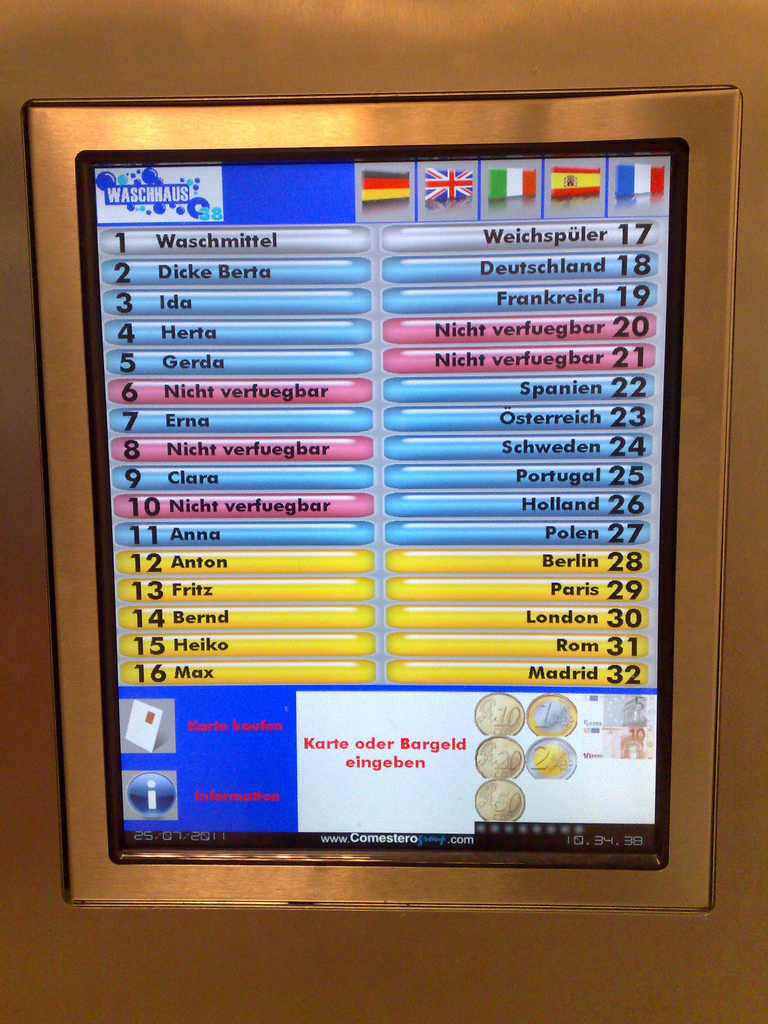
The wash cycles were between 30 and 45 minutes depending on the “program” selected (my selection of program was random and based on my mostly-wrong conception of proper laundering techniques). The dryers were €1 for 10 minutes of time, except for Anton, who costs €1,50 because he’s bigger; I ended up sending most of the dryers through 3 cycles, except for the load I’d washed with a high-RPM spin cycle, which only took 1 cycle (live and learn).
We were in and out and home in about 2 hours, and although laundry isn’t something you’d wish on anyone, it was a pretty painless way of doing it. I might even volunteer to go back next week (don’t tell Catherine).
On recent trips to Germany I’ve been using a pre-paid CallYa Vodafone SIM in my Nokia N95. For voice and SMS it’s proved just fine, and once I figured out that I could recharge it online, it was easy to top it up. Data, however, was a killer; although I was never sure just how much it was costing me for data, I had a visceral sense that it was a lot, as even just firing up Google Maps to fine out where I was seemed to drain €5 or more from my account.
While I naively thought that I could deal with this limitation on this trip to Germany, going back to old-school paper maps and chits of paper in my pocket, this system has proved ineffective: stumbling around looking for ones destination is all very well and good until you overlay cranky family members (and/or cranky self). Then you just really, really want to find the sushi place in a non-serendipitous way.
Getting information, in English, about pre-paid SIM options in a different country is always a challenge: long-term expats and bona fide locals are no help because they all have real mobile contracts and no nothing of the pre-paid world. Mobile shops are seldom help because they either don’t deal in the pre-paid market at all, or want to steer to you a contract because it’s better financially for them. And because the pre-paid market is mostly a local or national one, pre-paid provider’s websites, even for the big players like Vodafone, are usually not available in English.
In the past I’ve turned to Telestial, a U.S. company that specialized in helping travelers deal with the exact problem: they sell pre-paid SIMs from their website for a variety of countries, complete with English-language instructions and support. This has worked out well for me in Croatia and France on previous trips. But it’s not always the best deal, and Telestial SIMs don’t always include data.
So one is generally left to Google for help, and in this case the CCC Camp website proved an excellent pointer; in response to an FAQ about mobile data they write: “according to teltarif the cheapest prepaid options are NettoKom and Blau.de.” As it happens, NettoKOM happens to be the mobile offering from the Netto grocery store chain, and they have an outlet a block from our Berlin apartment.

So this morning on my way into the office I stopped by, found pre-paid SIMs boxed up by the counter for €5, and picked one up. I was able to activate the SIM from the Nettokom.de website through judicious use of Google Translate and some good guessing (note that you need the receipt from the Netto purchase to activate: you’ll be given a Kassencode PIN number that you’ll be prompted for during activation).
Once I activated online I had to wait 30 minutes, then turn the phone on, enter the PIN I received with it, and make a first call; at that point my balance online (or via the *100# service code) showed €5 and I was ready to go for voice and SMS.
For data the best option for me, with a North American phone that’s only EDGE-data capable, is the Internet-Flat S, which costs €4,90 for a month, and includes 100MB of data at “full speed” and then throttles the data back (to some unspecified degree) after that. As I’m never going to get “full speed” anyway, the throttle is of little consequence.
To add the Internet-Flat S to my account I needed to phone 1155 from the phone, press 8 for “service options” and then, listening carefully in German, navigating through to Internet packages and then the Internet-Flat S. I wish I could relate exactly which numbers I press, but I was fully focused on listening for keywords and numbers (and thankful for the German numbers practice Oliver and I did over the weekend – eins, zwei, drei). About 10 seconds later I got an SMS confirming the package had been activated, and I’m off to the rates: essentially unlimited data, 9 cents a minute for voice and 9 cents an SMS. For some reason I cannot fathom I can also make calls to the US and Canada for 12 cents a minute.
As a result of all this my mobile number in Germany has changed; if you happened to have the old one on file and I haven’t texted you an update, let me know.
One of the things that dramatic, if temporary, relaunches of living arrangements allow for is dramatic, if temporary, changes in habits.
For example, back in my regular everyday Canadian life, I’ve a longtime habit of working on Sundays. It’s not, to be honest, that there’s actually 6 days worth of work to day (although the quietness of Sunday working does allow for super-productive working, usually). It’s just that absent church, hockey or family, there’s not that much to do on a Sunday in Prince Edward Island, at least in the winter, and rather than face the endless drear, I seek solace in the arms of another.
In the grander scheme of things this isn’t a good thing, per se, and my more balanced European colleagues (okay, just Olle) have been known to point that out. But habits die hard.
At least until you relocate to Berlin.
I made a conscious choice not to opt for the €25 “24/7” access here at Betahaus in part to make it impossible to work over the weekend. And, of course, there’s much more to do in Berlin on the weekend, and much more of it has the potential of Maximum Fun, so this really wasn’t a hard decision to make. Oliver too has helped in this effort, insisting at every turn on the importance of “nobody feeling left out” if we don’t do things together as a family.
This Saturday’s version of “not going to work” went something like this:
- 9:00 a.m. – Household slowly wakes up.
- 10:00 a.m. – We all head downstairs to Kaffebar, the coffee shop under our house and over a few storefronts, for a languid breakfast of bread, cheese, fruit salad and coffee.
- 11:15 a.m. – On the U-bahn (subway) we head north to Bernauer Straße where we join the throngs heading toward the Mauerpark Fleamarket (as I described it in an email to G., “think of the 70-mile coastal yard sale crammed into Hillsborough Square in Charlottetown”).
- 12:30 p.m. – Abandoning the idea of a family-wide amble given the crowds and different amble-pacing, Oliver and I head off to the distant multi-coloured playground while Catherine continues on. The playground proves formidable, both for the physical feats required to climb up it, and for the swarms of kids “in the way” (as Oliver describes them).
- 12:45 p.m. – Catherine’s had enough of the crowds; Oliver’s had enough of the other kids fighting for playground supremacy, so we rendezvous and Catherine and Oliver share a fresh waffle with Nutella.
- 1:00 p.m. – Walk around the corner to Bonanza Coffee for more (very good) coffee.
- 1:15 p.m. – Wander about the neighbourhood. Break into temporary argument about “wandering without a purpose in mind” (I am the purposeless wanderer, Catherine is not; I probably didn’t need to tell you that).
- 1:30 p.m. – Argument still simmering, we head to the U-bahn again (thankful for the “day tickets” we purchased, which means we don’t have to worry about finding change for the ticket machines every time we want to move). Our (purposeful) destination is Café Garbáty in nearby Pankow which I’ve come to believe, thanks to Google Translate and Zitty, is having a special family afternoon with cake, sausages and family fun.
- 2:00 p.m. – Argument waning: arriving early we head to nearby playground and Catherine and I watch Oliver make himself completely and utterly dizzy (to say nothing of filled to the gills with sand) figuring out how to make the spinning-around playground equipment spin around. Our experience of Berlin playgrounds to date is that they are way, way more fun than stock Canadian ones.
- 2:30 p.m. – Head to Café Garbáty. Not sure what to expect. We are greeted at the door (of an otherwise empty bar) by very friendly owners and ushered into the back garden where we are offered drinks and provided with crayons, markers and paper for colouring fun.
- 2:45 p.m. – Challenging conversation with one of the owners, an older woman who speaks very little English to match our very little German. We both appear to be under the impression that if we speak with conviction in our native language the other will somehow figure it out. This is not true.
- 3:00 p.m. – After 30 minutes of colouring fun, still no other kids in evidence. Wind is picking up and rain is threatening so we head inside.
- 3:10 p.m. – Cake is brought to our table; wonderful, fresh cherry cake. And hot tea. And more colouring materials. Another family arrives! Other family turns out to be half English and half German and their two kids, younger than Oliver, bring a much-needed “family fun” element to the family fun day.
- 3:30 p.m. – Velcro darts. Play with balloons. Conversation about kid-friendly places in Berlin, contrast between Canadian and American border guards (was there ever a more useful conversational fallback than that one?).
- 4:30 p.m. – After more colouring, distribution of gummy bears, and a full album’s worth of Joni Mitchell on the stereo, and with still we two families holding up the “family” part of the equation, we think about heading off, but then there is word that the barbeque is on and steaks and sausages will soon be on offer.
- 5:00 p.m. – Steaks and sausages; very good. More balloon fun.
- 5:30 p.m. – Finally ready to head off; Catherine goes over to the bar to settle up: total bill for everything, for all three of us, comes to €10, which seems like the family fun deal of the century to us. We say our good-byes to everyone and head off.
Part Two of the “old habits die less hard” continued this morning when Oliver and I headed off to do the laundry together; but that’s another story.
Oliver has developed, of his own accord, very strict rules for what types of films he will watch: no violence, no horror, no vampires. On occasion he will add new items to the list, like “no dark magic” or “no boring movies,” the latter a hedge, I think, against the possibility of me taking him to non-violent movies that are otherwise of no interest to a 10 year old.
If you add the requirement that films be in English – I’m still reeling myself from sitting through The Band’s Visit with Danish sub-titles, to say nothing of watching Pirates of the Caribbean dubbed into French, which almost killed me – this narrows down our film opportunities here in Berlin somewhat.
Last night, with Catherine off drinking tea with the knitting hackers, we were left to our own devices. It was raining out, and yet too early to go to bed. What to do? A Google of Berlin Showtimes started us off on an extended father-son filtering session out the end of which came Win Win, playing in English at the nearby Babylon Kreuzberg.
The trailer suggested it was a feel-good story of redemption, but what about the possibility of violence. Or horror. Or vampires. These days one doesn’t know when a vampire might suddenly pop into an otherwise regular everyday movie after all.
Thank goodness for the BBFC – British Board of Film Classification – and its shockingly thorough ratings, like this one for Win Win that says, in part:
WIN WIN is a comedy drama about a small town attorney and part-time high school wrestling coach who spots star potential in a troubled runaway. The film was classified ‘15’ for strong language.
The film contains multiple uses of strong language and so exceeds the terms of the BBFC’s Guidelines at ‘12A’/’12’ which state ‘The use of strong language (for example, ‘fuck’) must be infrequent’. However, the uses are permissible at ‘15’ where the Guidelines state ‘There may be frequent use of strong language’.
The film also contains some mild violence, in the form of high school wrestling matches, and infrequent mild sex references as a character worries about who his ex-wife is ‘having sex’ with. There are references to one character being a ‘druggie’ and a moment of natural nudity as a character takes a photo of his bare bottom. There are also some references to and scenes of smoking, including some by a 16 year old boy. However, the boy quits when he realises smoking is incompatible with his sporting ambitions and the film as a whole does not endorse or glamorise smoking.
So, violence limited to mild wrestling. Some smoking. And a fuck or two. It passed my filter and Oliver’s both.
The BBFC rating of “15”, by the way, is interesting in contrast to the rating of “6” here in Germany.
In the UK the “15” rating means “No one younger than 15 may see a ‘15’ film in a cinema,” where as the German rating is “Released to age 6 or older.” Different cultural traditions, I suppose. (In Ontario, by contrast, it’s rated 14A, which means “Suitable for viewing by persons 14 years of age and older. Persons under 14 must be accompanied by an adult.”)
We walked up to the Babylon for the 8:00 p.m. show, bought our Ritter Sport chocolate bar and green iced tea, sat through a seemingly-endless run of advertisements and coming attractions, and watched the show.
There was nothing at all in the movie that concerned me as regards Oliver’s eyes, and when we emerged 2 hours later he seemed to agree: “good movie,” he said.
It took almost 36 hours for the blue ink to really dry (the last thing I wanted to do after all that work was to have Berlin smear in transit). And so 20 postcards went into the Andere Postleitzehelen slot this morning on their way to Germany, Sweden, UK, USA, Canada and Taiwan.
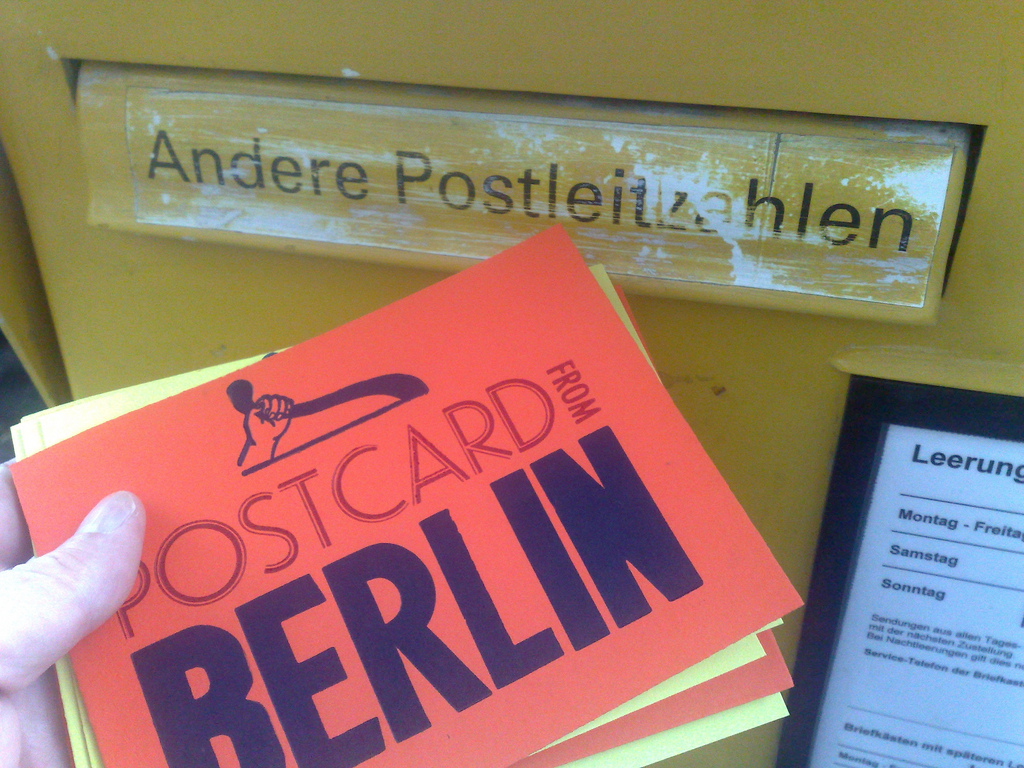
As I often hold friends and family to task for not communicating more about the mundane day-to-day details of their world travels, I present here the first 2 hours of Thursday, July 21, 2011:
- 8:01 a.m. – Woke up to the sounds of street machinery on Graefestrasse; they are ripping up parts of the sidewalk this week and they start work early. There seems to have been a little competition this morning between the workers, making the street a mess, and the street cleaners, making it clean. Together they made a lot of noise.
- 8:05 a.m. – Checked on the progress of my XCode 4 download to my MacBook. I had to reinstall OS X Snow Leopard yesterday after my hard drive’s kernel extension got borked, seemingly over a conflict with the portable Seagate GoFlex drive I purchased just before we left. Firefox reported 15 hours to go, so I suspended the download.
- 8:15 a.m. – Showered in the tiny, tiny bathroom. It really is tiny. But it works, and if you plan the shower curtain placement right you only get a little bit of water on the floor.
- 8:25 a.m. – Catherine’s awake. Asks if I’m leaving right away or if I can get her coffee first. As averse as I am to interruptions in the flow, love conquers all, and I reroute my plan for the next 30 minutes.
- 8:30 a.m. – Downstairs and over 2 doors to the Kaffebar, a coffee place that opened, as luck would have it, the same day we arrived in Berlin. Ordered an espresso macchiato and a cappuccino to go; received the macchiato but a croissant in place of the cappuccino because, well, I have an espresso macchiato and a croissant every day and coffee shop owner is also averse to interruptions in the regular flow. Cappuccino obtained. Kept the croissant for Oliver.
- 8:45 a.m. – Upstairs. Oliver’s awake now and in fine form, galloping all over the apartment. Wolf down my macchiato and pack up my digital gear.
- 9:02 a.m. – Kiss Catherine and Oliver good bye and head off to Betahaus, a 15 minute walk away, to start my work day. The walk takes me up Graefestrasse, over the canal and up to Kottbusser Tor and then around the corner and through the park and along Prinzessinnenstraße to Betahaus. I have yet to figure out how to pronounce Prinzessinnenstraße. Mornings are my favourite time in Berlin: the air is still cool, the streets are relatively deserted and there’s a sense of expectation in the air.
- 9:17 a.m. – Arrive Betahaus. Preparations in the first-floor café for the “BetaBreakfast” are in full swing – it’s a weekly free breakfast that Betahaus hosts and includes speakers on various topics. I consider staying down in the café, but I have a lot of work to do and Catherine’s handing over Oliver at 1:30 p.m. to go and spend the afternoon talking knitting and hacking.
- 9:30 a.m. – After a quick blueberry muffin in the café I head into the bizarre dinosaur of a freight elevator up to the third floor “coworking” space – I should take the stairs, but I don’t have the energy for it today. I find myself a desk with a green dot on it – the signal that it’s a “flexdesk” for people like me – and set down my MacBook.
- 9:34 a.m. – On the other end of the third floor is a bank of lockers where I keep my full-size keyboard, mouse and various cables; I walk over and grab it all, trying and failing to be ginger in my steps so as to not disturb the nearby knowledge workers (I’m still getting the hang of “corworking”).
- 9:45 a.m. – Get everything plugged together: every day is a reassemble-work-tear down cycle when you’re “hot desking.”
- 9:50 a.m. – Start the XCode 4 download again. This time, with more bandwidth, it reports 46 minutes to download.
- 9:52 a.m. – Start writing a little blog post (this one, as it turns out) about the mundane parts of our life in Berlin. “I’ll just take 8 minutes to dash this off before I set down to work,” I tell myself.
- 10:13 a.m. – I am nothing if not incapable of judging how long it takes to do things; 21 minutes later I finish the blog post and set to work.
I’ll be here at Betahaus for the morning – I’ll likely grab a quick lunch in the café around 11:30 a.m. – and then Oliver and I will head off for father-and-son adventures for the afternoon.
So, there you have it.
Yesterday was my first of five scheduled dates in the letterpress studio at Druckwerkstatt. Regular readers may recall that, thanks to the eagle-eyededness of my friend Luisa back in February when having supper downstairs at 3 Schwestern (“I think there’s something to do with letterpress printing in this building”), I discovered this print studio arm of Kulturwerk, a non-profit “infrastructure for the arts” organization in Berlin.
After some backing and forthing by email with Doris, the helpful Druckwerkstatt administrator, I made arrangements – at the very reasonable price of 8 euro a day – to spend every Tuesday of our summer in Berlin using their printing equipment. And yesterday was the first Tuesday.
At the appointed hour of 9:00 a.m. I arrived at Doris’s office to find that Doris had left for vacation and there was no record of me. Fortunately Doris’s replacement kindly pulled together the various pieces of paper and obtained necessary signatures to make me official, and then introduced me to Mathias, the director, who gave me a whirlwind tour of the printing facilities.
To get from the main office, which sits just above 3 Schwestern, down into the letterpress studio you enter a tiny elevator and go down two floors into the basement whereupon you enter a rabbit-warren like network of rooms holding printing, binding and cutting equipment, with the halls filled with drawer after drawer of metal type.
There are many amazing things about Druckwerkstatt – offset presses, screen printing workshops, digital plotters, bookbinding shops. Alas it turns out that letterpress printing is the sort of forgotten cousin of the group. There is scads and scads and scads of metal type – I’d hazard a guess that there are at least 200 fonts – but nary a fully operational “personal-sized” letterpress in sight.
Mathias suggested that I use the old Gutenberg-style press as a backup, but then it turned out there wasn’t even a chase for the type, which would have made that almost impossible.
Fortunately at this point Frank turned up. Frank is the amiable manager of the print studio, and he sprang into action suggesting that although it would be nigh unto impossible to set smaller metal type, we could use the partially-functioning proof press – a Grafix-brand press and operates much like a Vandercook – with larger wooden type, manually inked with a brayer, to get me going (he also referred me to the neighbourhood Linotype shop; is there nothing that Kreuzberg cannot provide?).
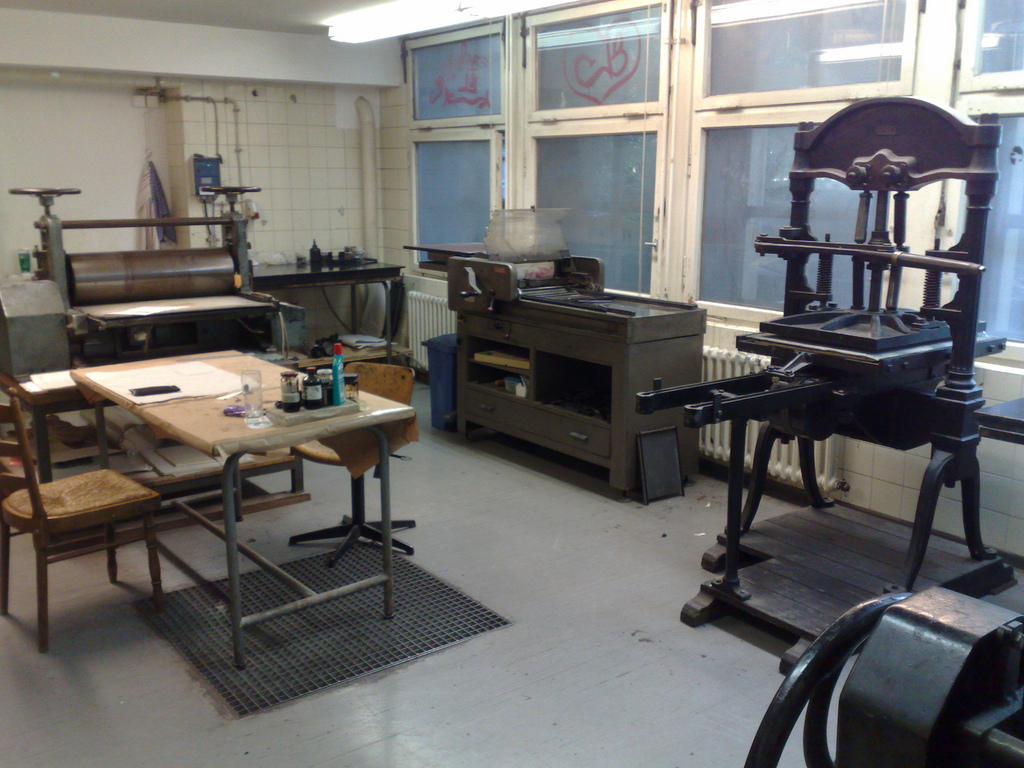
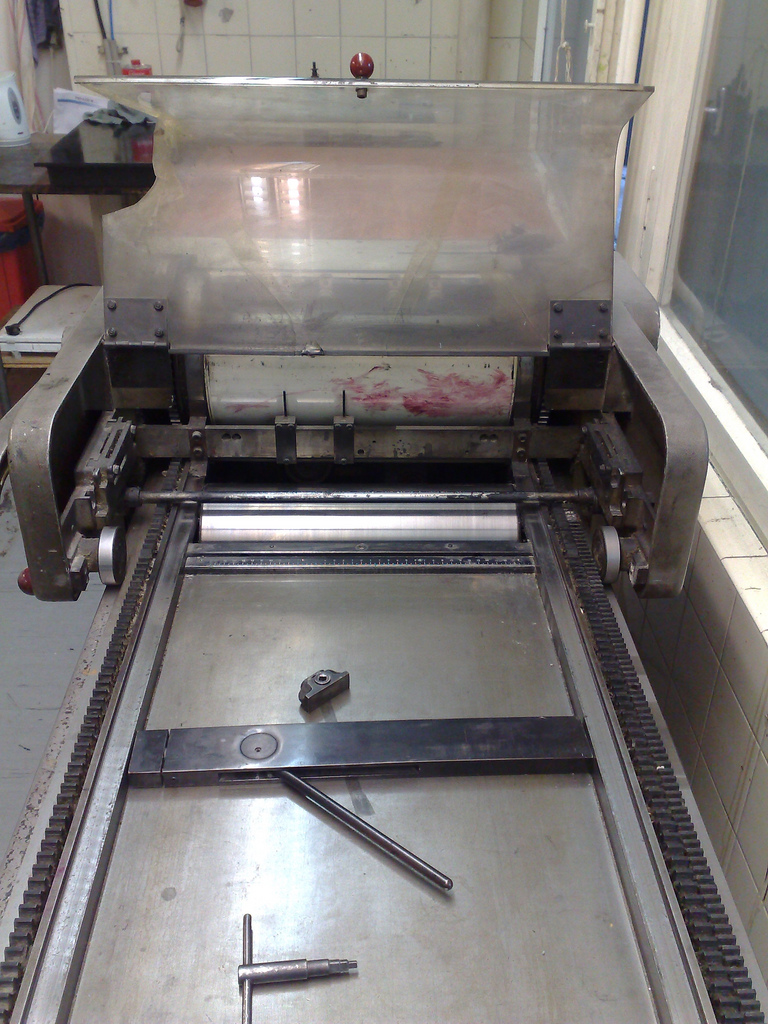
I pawed through the wood type drawers and found enough type to set some dinosaur-sized business cards for my friend Morgan and Frank guided me through the process of setting the type in the bed of the press, locking it into place, inking it, setting paper into place, and then rolling the paper over the inked type to print. Our “makeready” – getting to the point where all the letters printed equally and well – took about 45 minutes and then Frank left me on my own to explore and experiment as I might.
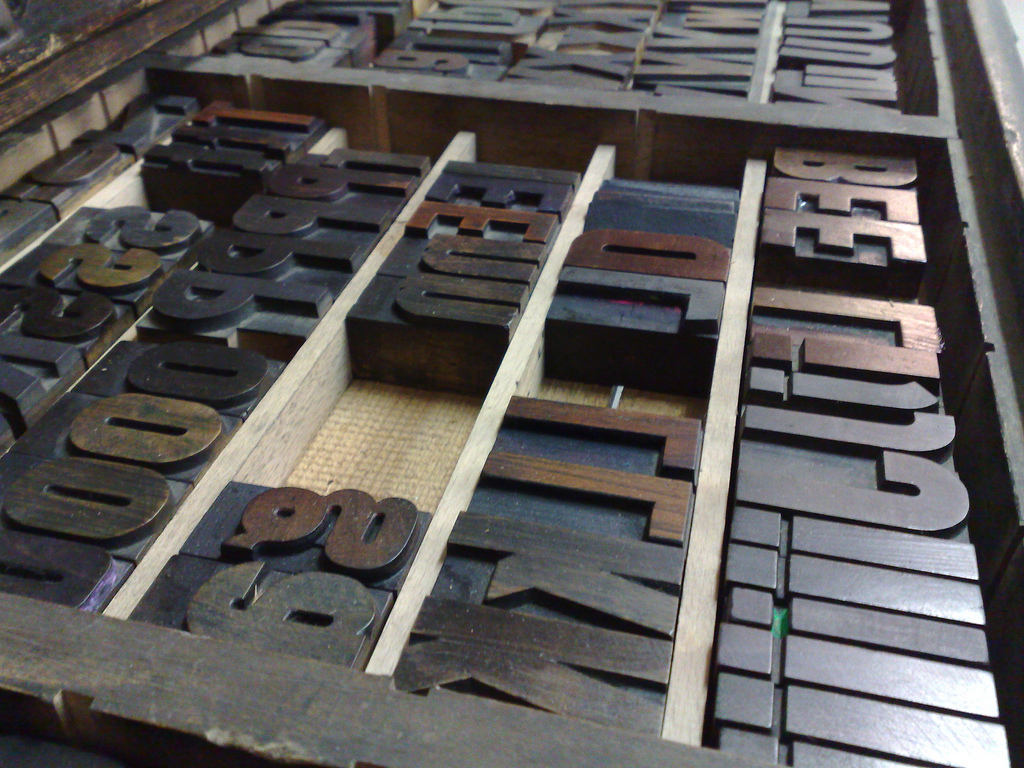
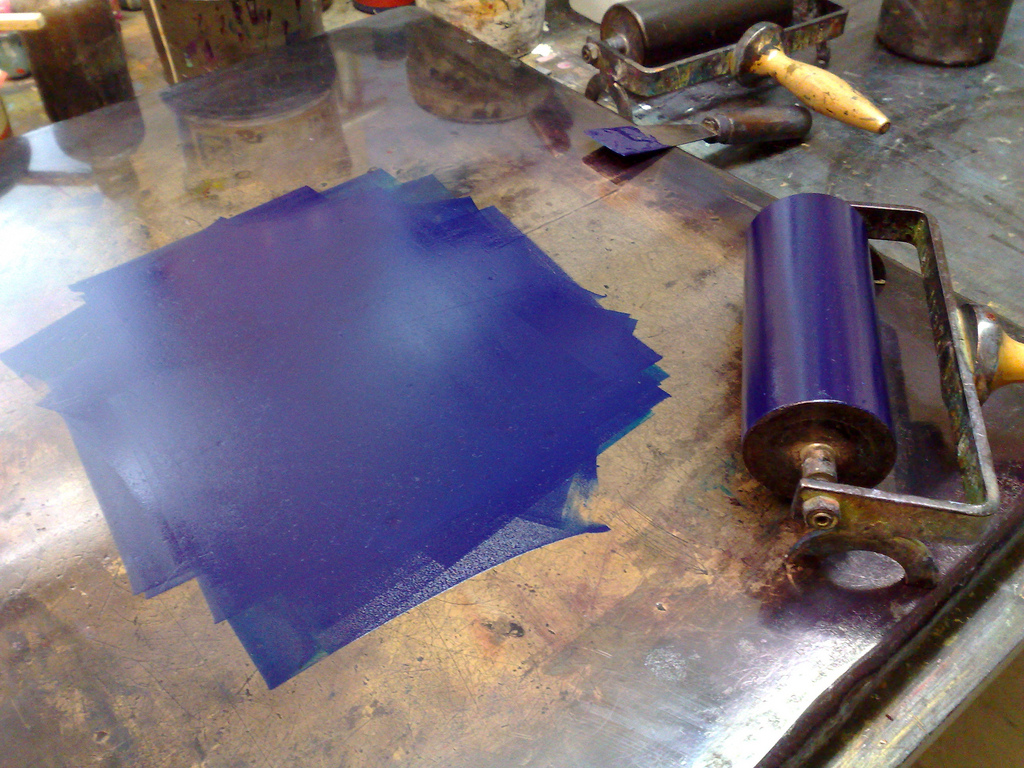
I printed a run of 16 cards for Morgan, cleaned everything up, and then set and printed 20 two-colour postcards to send out to my subscribers (you too can become a subscriber and received something letterpress-printed in the mail).
“Set and printed” makes it seem simple, but what with finding all the type I needed, setting it all up, inking and printing and cleaning up and then repeating for the second colour, it took about 5 hours in all (and thus about 15 minutes per postcard; one quickly sees why the laser printer was invented for rush jobs).
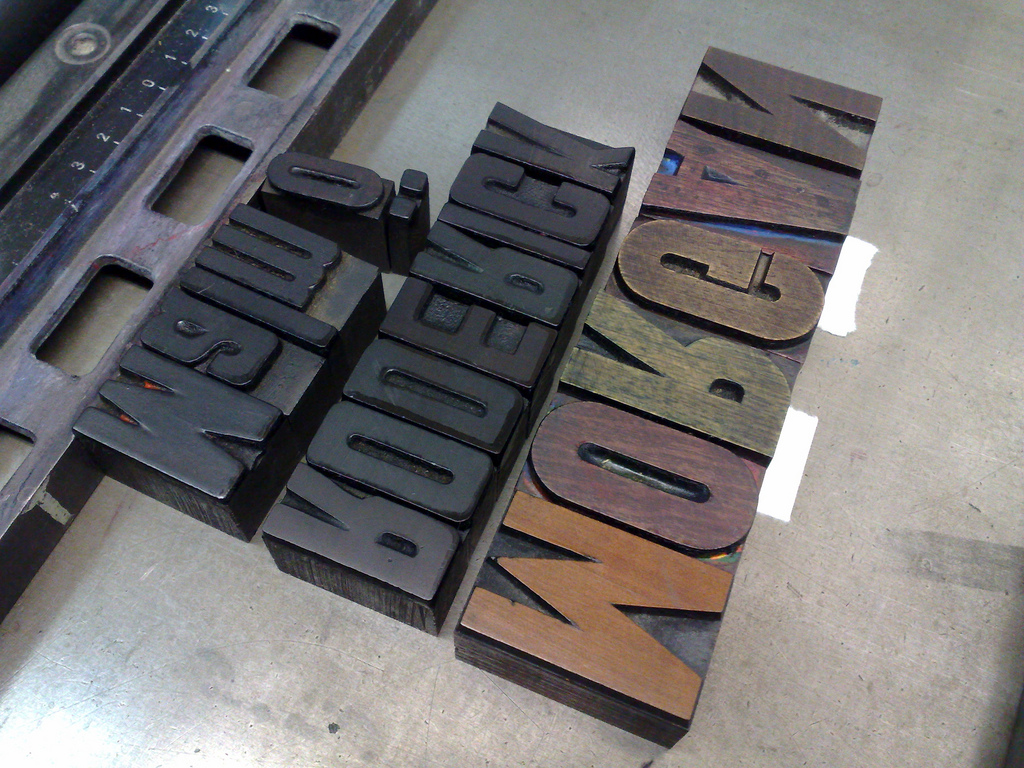
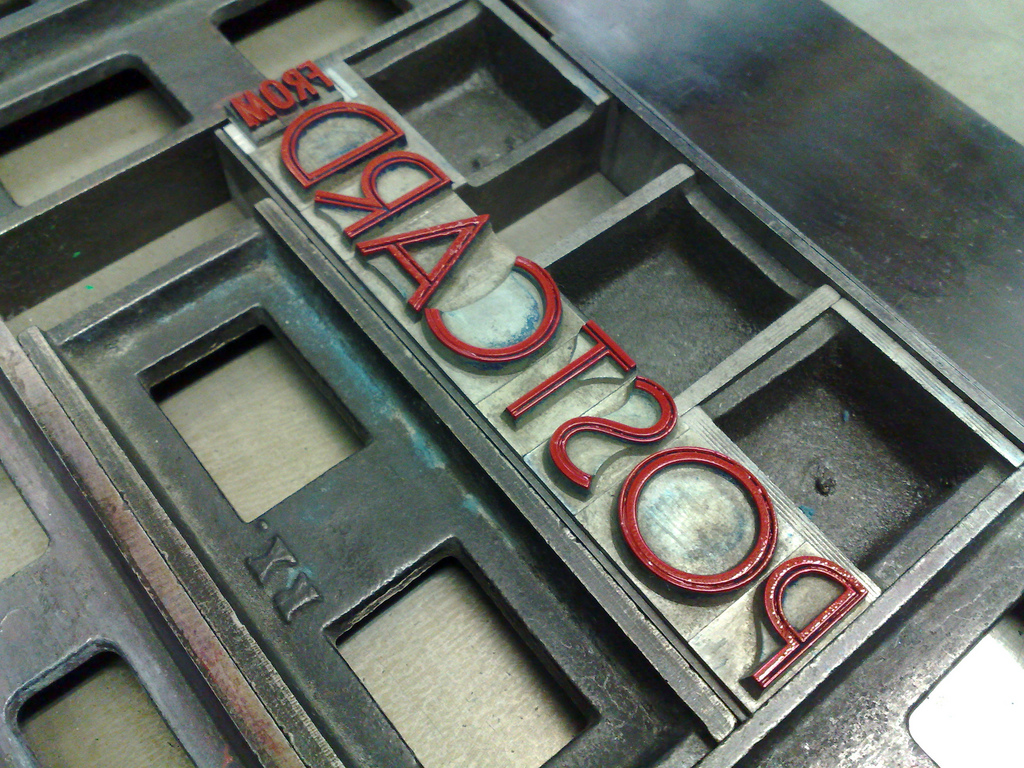
If you want to get the flavour of what Druckwerkstatt feels like, here’s a video I shot walking the hall of the basement print studio, then taking the elevator upstairs and out of the building. You can get a preview of the postcards drying at about one minute in.
I’m headed back to the shop later today once everything has dried to trim up the postcards; if everything goes according to plan they should be in the mail tomorrow morning.
In the meantime I’ve emailed Mathias about the possibility of breathing some new life into an old flywheel-equipped platen press in the hallway that seems to be in good working order but that’s sitting unloved and unused; perhaps that will be next Tuesday’s project.
When I saw that Freiluftkino Kreuzberg, the open-air cinema in our Berlin neighbourhood, was playing Der Zauberer von Oz (The Wizard of Oz) last night, I reckoned we had to go.
Not only is it Catherine’s favourite movie (a fact that was a touchstone during our wooing), but being able to go to the movies outside – outside! – was the whole reason I dragged my family to Berlin for the summer in the first place (well, maybe not the whole reason, but…).
As it turned out, after a week of build-up (and beautiful weather), it started to rain yesterday about supper time, and it looked like our plans were dashed.
My brother Steve once said that my primary motivation in life is to do things that result in good stories. And he’s right: story is everything for me, and I’ll do a lot of things that are otherwise mildly uncomfortable if there’s a chance that a good tale to tell will result (why else would I have carefully constructed a situation where I’d get coffee thrown at me?).
Catherine, on the other hand, gets her kicks from other things, and story, at least in the way that I think about it, means almost nothing to her.
Which is to say that the opportunity to see The Wizard of Oz in the pouring rain, favourite movie or no, was not something Catherine would jump to.
Oliver, on the other hand, had been looking forward to this all week. And yesterday he was counting down the hours – “the iPad says 17:30, when is 21:30?” – and coming up with clever rebuttals to our suggestions that movies in the rain were not pleasant (“Your clothes will get wet!” said we; “They’ll dry out!” said he).
Admiring his pluck, and realizing that “remember that time we didn’t go and see The Wizard of Oz in the rain in Berlin” doesn’t cut it as a story, I was in.
Oliver was very prepared, with rain pants and a rain jacket. I was not prepared at all, and so borrowed Catherine’s rain jacket (the sight on me in which made Catherine and Oliver both break down in laughter for some reason). And off we set.
The Freiluftkino is in the back yard of the same Kunstquartier Bethanien that’s home to Druckwerkstatt, where I’ll be printing tomorrow. It’s about a 15 minute walk from our apartment, and in that 15 minutes we managed to get ourselves awfully wet. It was raining.
We arrived at the box office around 9:15 p.m. to find ourselves the first ones to arrive. They told us that the show wouldn’t go on unless 5 people showed up and, as luck would have it, as soon as they said that another 3 brave souls showed up. A few minutes later 2 more people showed up. We paid our admission, bought beer, apple juice and M&Ms at the concession, and, to our surprise and delight, found our way under one of three giant beer umbrellas at the back of the field.
The chairs were a little wet, and the rain blew in from time to time when the wind picked up, but otherwise we were mercifully dry for the night, and our worst enemy became not the rain but the mosquitoes (and even they weren’t too bad).
The manager came out a few minutes later and said something in German that I feared was “even though there are seven of you we have had to cancel the show because the projector is under water.” When he repeated it in English, though, it turned out to be “the weather for The Wizard of Oz this year is much better than it was last year; this is the original print; there’s coffee and tea at the concession; enjoy the show.”
And then we were off to see the wizard (in English with German subtitles).
I hadn’t seen the film in over a decade – the last time was before Oliver was born when I snuck Catherine, blindfolded, into the Somerville Theatre in Cambridge, MA for her birthday – and I really, really enjoyed it. Nothing like seeing a tornado-themed movie when the wind and rain are swirling all around you. And think of the vocabulary we learned from the subtitles – worth the trip alone – Hexe (witch), Gehirn (brain), Herz (heart).
I also came to realize that whereas I thought Seinfeld and The Simpsons were responsible for most of the popular sayings to emerge from the 20th century, really everything came from The Wizard of Oz.
The movie finished up around 11:30 p.m. We suited up and headed back out into the rainy Berlin night; back at the apartment we peeled out of our wet clothing, I tucked Oliver into his bed in the kitchen, and we dreamed dreams of talking trees and ruby slippers.
I left this apartment this morning before Oliver woke up – he’s still getting used to European time and was up until 11:00 p.m. last night – and so when he woke up I wasn’t there.
He obviously needed to tell me something, and, absent his own mobile phone or a way of coming to visit me on his own, he routed his feedback into the only mechanism he had available: comments on this-here blog.
I suppose I need to prepare myself for his teenage years when his comments will no longer be plaintive “come on dad you left me here with mom without you” but rather more “I hate you and everything you represent and this blog is stupid.”
I will enjoy the “at daylight I am writing on your side of the screen” while I can.
Six years ago I first met Martin Roell thanks to a Plazes-fired happenstance at the reboot conference in Copenhagen. It was and remains the nonpareil Plazes moment: a geo-social meetup of the like-minded. It never, alas, happened again. At least in that happenstancy a way.
But the echoes of that moment keep resounding: Ton was also there that night, and I’ve been doing some Drupal migration work with him on the ePSIplatform (we’re also both shareholders in a boat); we had Skype call just yesterday from here at Betahaus where I’m renting a desk for the summer to his office in
And this morning the happenstances kept stancing: walking into Betahaus this morning I found the “betabreakfast” about to start – it’s a sort of one-hour Zap Your PRAM held every Thursday morning – and who should I see sitting at the breakfast table but the selfsame Martin.
Once the festivities were over, we had a good chance to catch up on the last 4 or 5 years since we’d seen each others – monasteries, children, travel, work, life – and we made plans to reconnect in August. It was like meeting an old friend. Actually, it was meeting an old friend.
The moral of this story: fleeting connections, no matter whether they are geo-enabled or happenstance of a very analog sort, can be a wonderful, enabling thing. Perhaps the best reason to jam shyness propensity into the deeper recesses.
 I am
I am